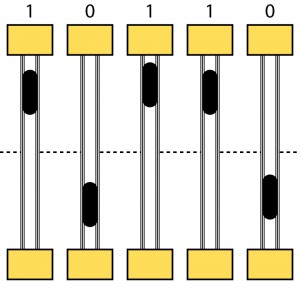Billion-year ultra-dense memory chip developed

There's always been an inverse relationship between density and durability when it comes to data storage. Today's silicon memory chips contain a lot of density, but with a lifespan of just a few decades, they lack durability. Yet primitive forms of storage such as information carved in stone are highly durable, however, they are not dense. Now this long-standing negative correlation between density and durability has been blow to bits with the development of a new memory device that can pack a trillion bits of data into one square inch of medium and retain that data for a billion years.
Led by physicist Alex Zettl, researchers with the U.S. Department of Energy’s Lawrence Berkeley National Laboratory (Berkeley Lab) and the University of California (UC) Berkeley, have created a digital electromechanical memory device that consists of a crystalline iron nanoparticle shuttle approximately 1/50,000th the width of a human hair enclosed within the hollow of a multiwalled carbon nanotube. The shuttle can be moved reversibly via a low-voltage electrical write signal and can be positioned with nanoscale precision, forming the basis of a binary sequence.

The nanoscale electromechanical memory device can write/read data based on the position of an iron nanoparticle in a carbon nanotube. The memory devices here are displaying a binary sequence 1 0 1 1 0 (Credit: Zettl Research Group)
"Through this combination of nanomaterials and interactions, we've created a memory device that features both ultra-high density and ultra-long lifetimes, and that can be written to and read from using the conventional voltages already available in digital electronics," Zettl said. "Furthermore, as the system is naturally hermetically sealed, it provides its own protection against environmental contamination."
A paper by Zettl and team provides the specifics of the research where you can learn more of the technical details, but here's the key takeaway: "The position of the shuttle can be read out directly via a blind resistance read measurement, allowing application as a nonvolatile memory element with potentially hundreds of memory states per device. The shuttle memory has application for archival storage, with information density as high as 10E12 bits/in2, and thermodynamic stability in excess of one billion years."
Below is a short video that shows an iron nanoparticle shuttle moving through a carbon nanotube in the presence of a low voltage electrical current. The shuttle’s position inside the tube can function as a high-density nonvolatile memory element.
Some of the insipiration Zettl and his team drew upon to develop the new memory storage technology could be found in the irony of modern storage. In the paper, Zettl wrote: “Interestingly, the Domesday Book, the great survey of England commissioned by William the Conqueror in 1086 and written on vellum, has survived over 900 years, while the 1986 BBC Domesday Project, a multimedia survey marking the 900th anniversary of the original Book, required migration from the original high-density laserdiscs within two decades because of media failure.”
Zettl thinks the technology could be on the market within the next two years with sginifcant impact. But he's not alone. A similar proprietary memory technology called NRAM or Nano-RAM that blends carbon nanotubes with conventional semiconductors appears on the brink of commercialization.
This research was primarily supported by the U.S. Department of Energy's Office of Science through its Basic Energy Sciences programs.
If the name sounds familiar, you may recall that Zett's team created the carbon nanotube radio.